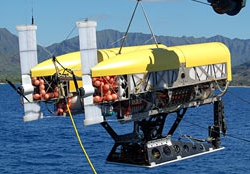Website: Nereus, the Oceanic Robot Hybrid
 The Woods Hole Oceanographic Institution, the world’s largest private non-profit oceanographic institution, offers an online interactive tour of its special underwater vehicle, Nereus. The Nereus page features a tour of the robot, videos, a slideshow, and related news.
The Woods Hole Oceanographic Institution, the world’s largest private non-profit oceanographic institution, offers an online interactive tour of its special underwater vehicle, Nereus. The Nereus page features a tour of the robot, videos, a slideshow, and related news.
About Nereus
Nereus is a hybrid, remotely operated vehicle that is exploring the oceans’ deepest depths. It works in two modes: as a free-swimming, autonomous robot that surveys wide areas of the deep sea and as a vehicle linked to a surface ship via a fiber-optic cable that transmits data and images up and sends commands down.
On its first mission, Nereus (rhymes with “serious”) explored the deepest part of the ocean, Challenger Deep—a nearly 7-mile-deep trench east of the Marianas Islands in the western Pacific. The trench extends farther below the sea surface than Mount Everest reaches into the sky. In the future, Nereus could also be used under ice-capped polar waters.
“Nereus” is a mythical Greek god with a fish tail and a man’s torso. The name was chosen in a nationwide contest open to junior high, high school, and college students.
Why Nereus is Called a “Hybrid” ROV
Nereus, an unmanned vehicle, operates in two complementary modes. It can swim freely as an autonomous underwater vehicle (AUV) to survey large areas of the depths, map the seafloor, and give scientists a broad overview. When Nereus locates something interesting, the vehicle’s support team can bring the vehicle back on board the ship and transforms it into a remotely operated vehicle (ROV) tethered to the ship via a micro-thin, fiber-optic cable. Through this tether, Nereus can transmit high-quality, real-time video images and receive commands from skilled pilots on the ship to collect samples or conduct experiments with a manipulator arm.
High-tech components make Nereus smaller and lighter, enabling the vehicle to travel deeper for longer periods
- When operating in ROV mode, Nereus trails a hair-thin optical fiber, up to 25 miles in length, from a support ship. Like a high-speed Internet connection, the fiber can transmit high-quality video images to scientists on the ship. It also enables Nereus’s operators to have precise, interactive control of the vehicle.
- Nereus uses lightweight ceramic materials to provide buoyancy and shield electronics from intense seafloor pressure, replacing traditionally used (but heavier) metals and glass materials.
- To supply energy, Nereus carries rechargeable lithium-ion battery packs, similar to those powering laptop computers. Each pack contain more than 2,000 batteries.
Filed under: Web Resources








